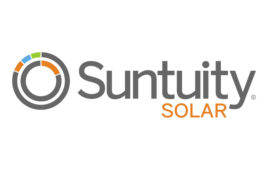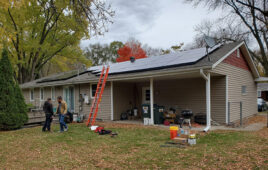 This past Monday, Feb. 17 was the deadline for comments regarding bifacial modules’ exemption from the Section 201 tariffs on all imported solar panels. Tariffs on all imported solar panels — not just those coming from China — were first initiated in 2018. Bifacial modules received full exclusion in June 2019 before their exemption was revoked in October 2019. The U.S. Court of International Trade (CIT) stepped in and reinstated the exemption in December 2019.
This past Monday, Feb. 17 was the deadline for comments regarding bifacial modules’ exemption from the Section 201 tariffs on all imported solar panels. Tariffs on all imported solar panels — not just those coming from China — were first initiated in 2018. Bifacial modules received full exclusion in June 2019 before their exemption was revoked in October 2019. The U.S. Court of International Trade (CIT) stepped in and reinstated the exemption in December 2019.
The U.S. Trade Representative (USTR) opened the bifacial exemption to comments because it is concerned that increased imports of untariffed bifacial solar panels will undermine the objectives of the original solar panel tariff. It was also looking for a more precise definition of a bifacial module.
Domestic module manufacturers (many that are major global brands with headquarters outside of the United States) unsurprisingly requested that bifacial modules not continue to receive tariff exemption. Large solar contractors and installers came out in favor of the tariff exemption. Of the nearly 20 submitted comments, here are some of the more significant:
Ohio-based solar panel manufacturer First Solar requested the bifacial tariff exemption be revoked. The CdTe thin-film panel company largely works in the utility-scale market, and stated that it is directly competing with bifacial modules on big projects. The company said, “Bifacial CSPV panels are not a niche product, but rather one of the leading types of CSPV panels in the market today, particularly in the all-important utility segment.” First Solar also stated that global bifacial production capacity is growing rapidly, driven in large part by the bifacial exclusion. Unless the exclusion is removed, First Solar expects bifacial modules to account for 25% of total U.S. solar panel imports this year and 40% by 2022.
Korean panel manufacturer LG (with a new 500-MW solar panel plant in Alabama) stated that “only complete termination will prevent significant harm to U.S. solar module producers.” The company also said that enforcement of the bifacial exemption will become more difficult for U.S. Customs and Border Protection as importers attempt to game the exemption. Using transparent backsheets or backside glass does not automatically make a solar panel bifacial, something that a lay-person may not realize.
Massachusetts-based wafer manufacturing technology company 1366 Technologies (which has a significant relationship with Korean panel manufacturer Hanwha Q CELLS, which opened a 1.7-GW panel assembly plant in Georgia last year) also wants the exemption revoked, stating, “The surge in bifacial imports has destabilized the effectiveness of the import relief.” The company also explained that because 91% of the global wafer market is owned by China, the exempted bifacial modules consist of Chinese wafers, which prevents 1366 from accelerating its production of U.S. wafer manufacturing equipment. If anything, 1366 requests that the bifacial exclusion should only be given to foreign-produced modules that use wafers made on U.S. equipment and with U.S. silicon.
Hanwha Q CELLS (domestic manufacturing in Georgia) and Auxin Solar (plant in California) jointly submitted comments in favor of revoking the bifacial tariff exemption. Auxin makes bifacial modules and plans to expand its 150-MW manufacturing plant but the bifacial exemption puts those plans in jeopardy. The two companies also believe that it is relatively easy for foreign manufacturers to switch their lines from monofacial production to bifacial products — something that can be switched over in fewer than four months. The groups are largely concerned that Chinese manufacturers will continue to flood the market with their tax-free panels. Georgia Department of Economic Development, the Dalton-Whitfield (Georgia) Joint Development Authority, the Whitfield County (Georgia) Board of Commissioners and Georgia Congressman Tom Graves also submitted comments in support of Q CELLS’ request that the exemption be removed.
Original Section 201 petitioner Suniva (which is trying to restart a domestic solar cell manufacturing program) urges the USTR to withdraw the bifacial exemption. Suniva said that while the exemption was granted one year ago to a “niche technology,” bifacial modules are quickly becoming more mainstream as foreign manufacturers rapidly convert existing monofacial capacity to bifacial.
Advocacy group SEIA supports continuing the tariff exemption but with a few modifications: only 1,500-V, 72-cell bifacial modules should have the exemption if their bifaciality factor is 60% or greater. If USTR is still concerned about a full exclusion, SEIA suggest that there be a tariff-rate quota for utility-scale bifacial modules of 8 GW per year.
Utility-scale solar contractor EDF Renewables submitted comments in favor of the bifacial exemption, since the initial exclusion was supported by “the lack of availability of sufficient quantity and high-quality bifacial solar panels from U.S. producers.” EDF said it continues to experience the same shortage of bifacial modules from domestic manufacturers.
Chinese panel company LONGi Solar came out in favor of the bifacial panel exemption, also stating that U.S. bifacial panel production capacity is nearly non-existent. Contrary to First Solar’s bifacial import estimates, LONGi expects bifacial modules to account for only 11% of U.S. installs in 2020 and 38% by 2024 (according to WoodMac data) — widespread adoption of bifacial technology is “unlikely to occur in the near-term … in the United States.” LONGi also supports a bifacial exemption to modules with a bifaciality rating of over 65%.
Utility-scale solar developer Invenergy, which was the first company to file a complaint against the USTR when the bifacial module exemption was first revoked in October 2019, is also unsurprisingly in favor of the bifacial exemption sticking around. The company suggested that the exclusion could cover only bifacial modules for the utility-scale market to alleviate the USTR’s concerns over the exemption undermining the objectives of the original Section 201 tariffs.
Finally, the Center for Biological Diversity wants the bifacial exemption to stay because the “urgency of the climate crisis demands that all available technologies to advance the clean energy transition be as available as possible.” The organization provided a lengthy outline of the future effects of climate change.
Responses to the above comments will be accepted through February 27, 2020.





“The two companies also believe that it is relatively easy for foreign manufacturers to switch their lines from monofacial production to bifacial products — something that can be switched over in fewer than four months. The groups are largely concerned that Chinese manufacturers will continue to flood the market with their tax-free panels.”
What is to be learned here? The Chinese have manufacturing facilities that are ‘apparently’ more flexible than a lot of the manufacturing facilities online now. The question, how does one ‘compete’ against this more flexible manufacturing technology? Perhaps it’s time for the crybaby U.S. manufacturers to use their very product to power their manufacturing lines. Large industrial plants, with all solar roofs, solar PV covered parking structures and perhaps even room for a 12MW wind turbine on site. Using energy storage these manufacturing facilities could drop their manufacturing costs to pennies per watt and compete due to the low cost product they would produce without onerous, electricity rates, demand charges and TOU rate periods of the day.